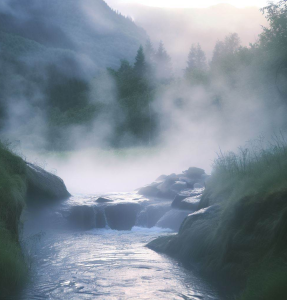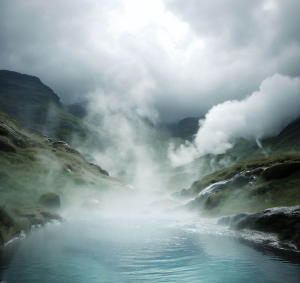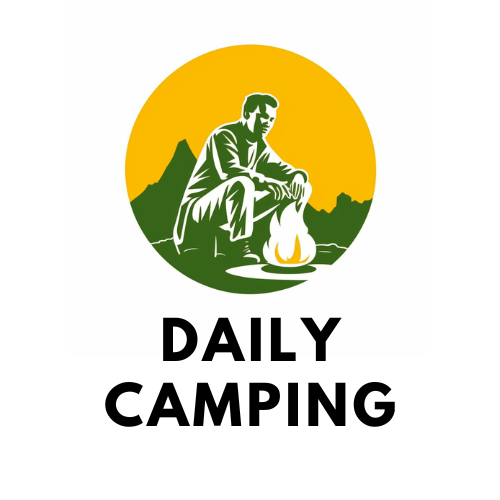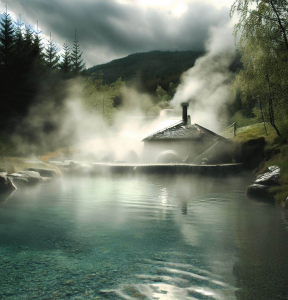
Norway is a country of stunning natural beauty, with majestic mountains, deep fjords, and spectacular glaciers. But did you know that Norway also has some hot springs? Although they are not as abundant or famous as those in Iceland or Japan, Norway’s hot springs offer a unique and relaxing way to enjoy the Nordic spa experience. In this article, we will tell you everything you need to know about hot springs in Norway, including where to find them, what to expect, and how to make the most of your visit.
What are hot springs and how do they form?
Hot springs are natural pools of water that are heated by geothermal activity underground. Geothermal activity occurs when water comes into contact with hot rocks or magma (molten rock) near the Earth’s surface. The water then rises to the surface through cracks or fissures, forming hot springs. Hot springs can have different temperatures, mineral compositions, and colors, depending on the source and location of the geothermal activity.
Hot springs are usually found in areas where there is volcanic activity, such as Iceland or Japan. However, Norway does not have any volcanoes, so how does it have hot springs? The answer is that Norway has some geothermal activity due to its location on the Mid-Atlantic Ridge, a tectonic plate boundary where the Eurasian and North American plates are moving apart. This creates some heat and pressure under the ground, which can sometimes result in hot springs.
Where are the hot springs in Norway?
Norway has only one natural hot spring that is open to the public: Stave Hot Pools. Stave Hot Pools is located in Nordmela, a small village on the island of Andøya in northern Norway. Stave Hot Pools is part of Stave Camping & Hot Pools, a camping site that offers accommodation, facilities, and activities for visitors. Stave Hot Pools consists of four wooden tubs that are filled with mineral-rich water from a nearby spring. The water temperature is around 40°C (104°F), which is perfect for relaxing and soothing your muscles. The tubs are situated on a hill overlooking the beach and the ocean, offering a stunning view of the scenery. You can also enjoy the contrast between the hot water and the cold air, especially in winter when snow covers the ground.
Stave Hot Pools is open all year round, no matter the weather. You have to book your time slot in advance and shower before entering the tubs. You can also bring your own drinks and snacks to enjoy while soaking in the water. The price for one hour in a tub is 250 NOK (about 30 USD) for up to four people. You can also rent towels and bathrobes for an extra fee.
Stave Camping & Hot Pools also offers other activities for guests, such as hiking, fishing, kayaking, whale watching, northern lights viewing, and more. You can stay in one of their cabins, tents, or caravans, or bring your own camping equipment. The camping site has a kitchen, bathrooms, showers, and a reception lobby. You can also buy souvenirs and local products at their shop.
Stave Hot Pools is about 1.5 hours drive from Andenes Airport or 2 hours drive from Harstad/Narvik Airport. You can also take a bus from Sortland or Harstad to Nordmela.
What are some other spa options in Norway?
If you are looking for more spa options in Norway, you can try some of the man-made hot pools or saunas that are available in various locations. These are not natural hot springs, but they still offer a relaxing and enjoyable experience. Here are some examples of spa options in Norway:
- Floating Saunas: In Oslo, you can find several floating saunas that are heated by wood fire and moored on the water’s edge. You can book a seat or a whole boat and enjoy the warmth of the sauna while admiring the view of the city and the fjord. You can also take a dip in the cold water for a refreshing contrast. Some of the companies that offer floating saunas are KOK Oslo1, Oslo Badstuforening2, SALT3, and Sauna Boat4.
- Spa Hotels: If you prefer a more luxurious spa experience, you can stay at one of the many spa hotels in Norway that offer various treatments and facilities for guests. Some of the spa hotels have indoor or outdoor pools that are heated by electricity or solar power. Some examples of spa hotels in Norway are Farris Bad in Larvik, The Well in Kolbotn, Norefjell Ski & Spa in Norefjell, Solstrand Hotel & Bad in Os, and Juvet Landscape Hotel in Valldal.
- Hot Tubs: If you are visiting the mountains or the countryside, you can rent a hot tub that is heated by wood fire and placed in a scenic location. You can enjoy the warmth of the water while surrounded by nature and fresh air. Some of the places that offer hot tub rentals are Preikestolen BaseCamp in Forsand, Canvas Hotel in Telemark, and Hindsæter Fjellhotell in Vågå.
How to make the most of your hot spring or spa visit in Norway?
Visiting a hot spring or a spa in Norway can be a wonderful way to relax and rejuvenate your body and mind. However, there are some things you should keep in mind to make the most of your visit and avoid any problems or discomfort. Here are some tips for enjoying your hot spring or spa visit in Norway:
- Check the opening hours, prices, and availability of the spa before you go. Some spas may require advance booking or have limited capacity or time slots. You can also check if they have any special offers or discounts for guests.
- Bring your own swimsuit, towel, bathrobe, slippers, and toiletries. Some spas may provide these items for free or for a fee, but it is always good to have your own. You can also bring your own drinks and snacks if you want, but make sure they are allowed by the spa rules.
- Shower before and after entering the hot water. This is important for hygiene and safety reasons, as well as for preserving the quality of the water. You should also avoid using any soap, shampoo, lotion, perfume, or other products that may contaminate the water or irritate your skin.
- Follow the instructions and signs at the spa. Some spas may have different rules or etiquette for using the facilities or equipment. For example, some spas may require you to wear a bathing cap or remove your jewelry. You should also respect the privacy and comfort of other guests and staff.
- Drink plenty of water and stay hydrated. Soaking in hot water can cause dehydration and overheating, which can lead to headaches, dizziness, nausea, or fainting. You should drink water before, during, and after your spa visit to prevent dehydration and replenish your fluids. You should also avoid drinking alcohol or caffeine, as they can dehydrate you further and affect your blood pressure.
- Limit your time in the hot water. Spending too much time in hot water can also cause health problems such as low blood pressure, heart problems, skin infections, or burns. You should limit your time in the hot water to 15-20 minutes at a time, and take breaks in between to cool down and rest. You should also avoid going to the spa if you have any medical conditions or are pregnant, unless you have consulted your doctor first.
- Enjoy the experience and have fun. Visiting a hot spring or a spa in Norway can be a great way to relax and have fun with your friends, family, or partner. You can enjoy the warmth of the water, the beauty of the scenery, and the benefits of the minerals and treatments. You can also try some of the other activities or attractions that are available near the spa, such as hiking, skiing, fishing, or sightseeing.
FAQs
- Q: Are there any hot springs in Norway?
- A: There is only one natural hot spring in Norway, which is Stave Hot Pools in Nordmela. It is a camping site with two outdoor pools that are heated by geothermal water. You can enjoy the views of the sea and the mountains while soaking in the warm water. You can also try the floating saunas in Oslo, which are not natural hot springs, but offer a similar experience of relaxing in hot water and plunging into the cold fjord1.
- Q: Which country has the best hot springs?
- A: This is a subjective question, as different countries may have different types of hot springs that appeal to different preferences. However, some of the most popular and famous hot spring destinations in the world are Iceland, Japan, New Zealand, Turkey, and Costa Rica. These countries have a variety of natural hot springs that range from mineral-rich pools to geysers to volcanic lakes. Some of them also have cultural and historical significance, such as the Roman Baths in Bath, England2.
- Q: Which Nordic country has hot springs?
- A: Iceland is the Nordic country with the most hot springs, due to its high volcanic activity and geothermal energy. Iceland has many natural hot springs and pools that are open to the public, such as the Blue Lagoon, Mývatn Nature Baths, and the Secret Lagoon. Hot spring culture is widely enjoyed in Icelandic society and for good reason3.
- Q: Are there any hot springs in Scandinavia?
- A: Scandinavia consists of three countries: Norway, Sweden, and Denmark. As mentioned before, Norway has only one natural hot spring, which is Stave Hot Pools. Sweden and Denmark do not have any natural hot springs, as they are not located on volcanic zones. However, there are some man-made spas and wellness centers that use geothermal water or artificial heating to create hot pools and saunas. For example, you can visit Ystad Saltsjöbad in Sweden or Kurhotel Skodsborg in Denmark for a relaxing spa experience.
Conclusion
Norway may not have many natural hot springs, but it still has some options for enjoying the Nordic spa experience. Whether you choose to visit Stave Hot Pools, the only natural hot spring in Norway, or one of the many man-made hot pools or saunas that are available across the country, you can have a relaxing and enjoyable time soaking in the hot water while admiring the stunning nature. Just remember to follow our tips for making the most of your visit and avoiding any problems or discomfort. We hope this article has given you some useful information and inspiration for your next spa trip in Norway. Have a great time!



